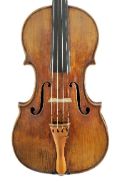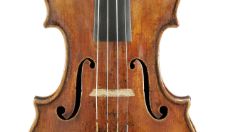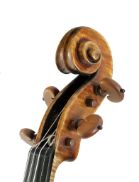Violin, Antonio Stradivari, Cremona, 1709, “ex Hämmerle”
Printed label: “Antonius Stradiuarius Cremonensis / Faciebat Anno 1709” (709 handwritten)Stradivari made the violin now designated as “ex Hämmerle” in 1709 during his Golden Period, when he was at the height of his powers as a craftsman. This era spanned the two first decades of the 18th century, more or less. The instruments he built during this time reflect consummate skill and beauty, but above all, they have exceptional sound potential. Many of the violins crafted around 1710, such as the “ex Hämmerle,” were built on the “P” form, which is housed at the Museo del Violino in Cremona along with other tools and models from Stradivari’s workshop. The bodies built on the “P” form, which is dated February 25, 1705, are ideally proportioned. The belly of the “ex Hämmerle” is made of two pieces that are likely to be from different logs. Its annual rings are medium wide and of very regular grain. The most recent annual ring was dated 1700. A dendrochronological analysis established that Stradivari also made the bellies of other instruments from the same log. The one-piece back displays lovely, regular flames descending slightly toward the bass side. The structure of the wood used for the ribs and head corresponds to that of the back. The medium-high arching is very gracefully curved, and the fluting is quite shallow. The f-holes are positioned very upright and have nearly perfectly circular eyes. The powerful, especially regularly carved scroll has a broad chamfer that has not retained its blackening; the eye on the bass side is somewhat lower than the one on the treble side. The lustrous, red-brown varnish is typical of Stradivari’s instruments from this period. Much of the original varnish is still intact, above all on the back. The overall condition of the instrument is very good.
Thanks to a certificate issued by W. E. Hill & Sons in 1907 for Theodor Hämmerle (1859–1930), the chain of title of this instrument can be traced far back: The violin was owned by the aristocratic Scottish family Clerk of Penicuik. Research has shown that Sir John Clerk, 2nd Baronet of Penicuik (1676–1755) was a music lover who played the harpsichord and violin and who also composed music. A Grand Tour from 1694 to 1699 took Sir John to continental Europe, where he also visited Vienna and was granted access to the court of Emperor Leopold I. His actual destination was Rome, where he stayed for several months. During this time, he repeatedly took lessons with Arcangelo Corelli. A comprehensive autobiography provides a vivid account of Sir John’s travels.1 Unfortunately, the memoirs do not mention specific instruments. It has not been possible to ascertain whether or when Sir John bought the 1709 Stradivari. Yet there is good reason to believe that it was he who purchased the violin. His offspring had no interest in music, aspiring to fine art and natural sciences instead. In 1907, Theodor Hämmerle obtained the instrument. Industrialist Hämmerle was a passionate collector of historical string instruments and a good cello player himself. Amateurs and professional musicians regularly came to his house to make music together. According to a handwritten attestation on the above-mentioned certificate, Hämmerle sold the Stradivari to Max Adler (1866–1952) in 1922, who took the instrument to the USA.
1 Memoirs of the Life of Sir John Clerk of Penicuik, Baronet. Baron of the Exchequer. Extracted by himself from his own Journal. 1676–1755. Edinburgh, 1892.






